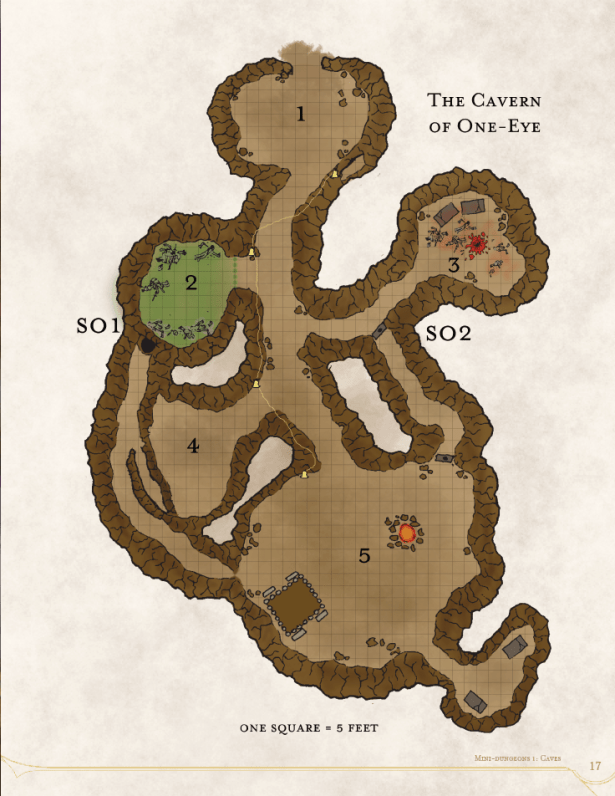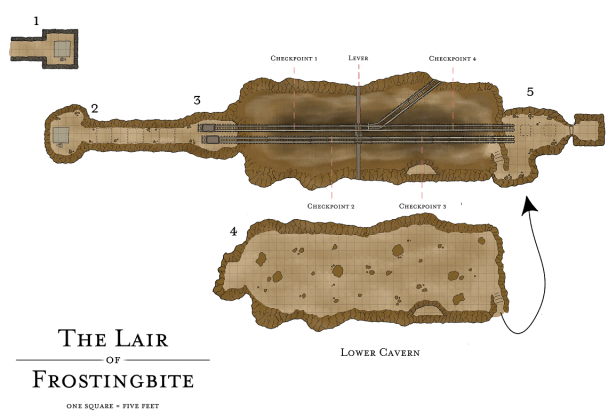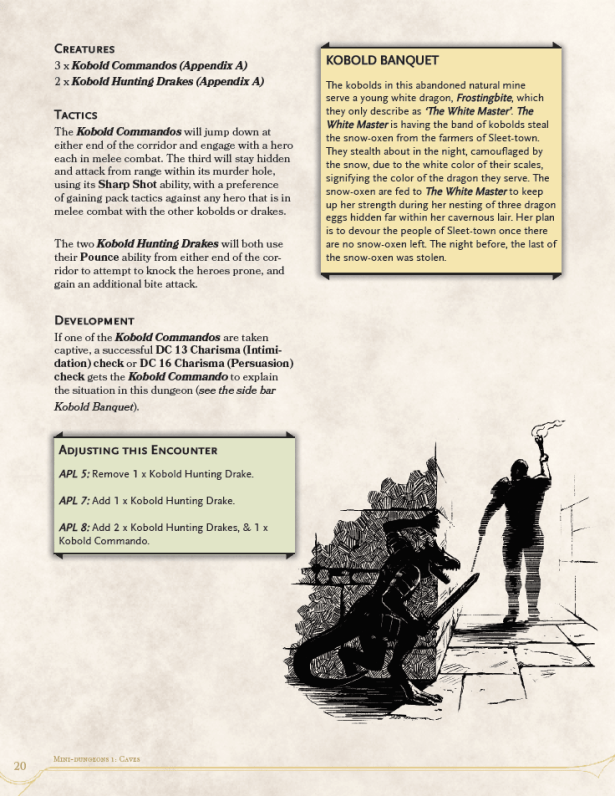A press copy of Mini-Dungeons #1: Caves was provided for the purposes of this review.
Designed by: Phil Beckwith and Chris Bissette
Published by: P.B. Publishing
 A mini-dungeon fills the gap between a one or two-room single encounter cave and a sprawling dungeon that contains a dozen or more areas. The 3-in-1 mini-dungeon compilation, “Mini-Dungeons #1: Caves,” contains three such in-between dungeons of about half a dozen rooms each, co-designed by Chris Bissette of Loot the Room and Phil Beckwith of P.B. Publishing.
A mini-dungeon fills the gap between a one or two-room single encounter cave and a sprawling dungeon that contains a dozen or more areas. The 3-in-1 mini-dungeon compilation, “Mini-Dungeons #1: Caves,” contains three such in-between dungeons of about half a dozen rooms each, co-designed by Chris Bissette of Loot the Room and Phil Beckwith of P.B. Publishing.
“Mini-Dungeons #1: Caves” includes a short, overarching narrative to tie all three previously released dungeons together, should you want to add them all at once. This pseudo-campaign adds a single NPC captive orc who motivates the PCs to travel from the first dungeon to the second, while their overall goal is to reach the third dungeon, along with some random encounters on the way.
It’s a weak thread as these dungeons were not initially designed to have anything to do with each other. Otherwise you can drop thesm anywhere you’d like your players to encounter a self-contained, combat-heavy side quest.
I’ll go over each dungeon separately but in general the first dungeon is designed for a level 2-5 party (Tier 1), while the other two are higher level and range from level 5 to 8 (Tier 2). Each one is designed as a one-shot with play times of only a few hours, though in my experience any combat-heavy scenarios always take significantly longer to play.
Mini-Dungeon 1: Lizardfolk Tunnels
If you have read my review of “Struggle in Three Horn Valley” you may recognize the Lizardfolk Tunnels, as it’s included as one of the possible encounters in that adventure. It ends up as the weakest dungeon here, which is more a testament to how great the other two dungeons are.
 The story hook presents the PCs with a woman whose husband has been recently murdered by lizardfolk. Her two children have been dragged off to the nearby caves. She is having a remarkably awful day, but hopefully the stalwart PCs can salvage some of it.
The story hook presents the PCs with a woman whose husband has been recently murdered by lizardfolk. Her two children have been dragged off to the nearby caves. She is having a remarkably awful day, but hopefully the stalwart PCs can salvage some of it.
The Lizardfolk Tunnels are a standard cave dungeon with not much going for it. It features, you guessed it, lizardfolk. Near the entrance the PCs can rescue one of the kids from a sacrificial altar, then proceed room-to-room battling lizards until they reach the arena at the bottom. There they find the other captive kid and a lizard king boss fight.
It’s not a horrible design but there’s nothing particularly memorable about it, nor are there any notable traps, secrets, or environmental hazards. An overhang with a giant eagle nest has potential interest, but the PCs aren’t meant to actually interact with it at all.
The map itself is drawn in an isometric or cut-away style. While I do like this art style it’s not usable in virtual tabletops like Roll20, forcing me to rebuild a top-down battle map.
Mini-Dungeon 2: The Cavern of One-Eye
A cave filled with orcs isn’t usually the most compelling dungeon design, but The Cavern of One-Eye does some really fun things in its design, including poisonous rooms, multiple secret paths and ledges, an alarm system, and rescuing a potential cyclops ally!
The inciting story hook is almost the exact same as the Lizardfolk Tunnels. The PCs meet a bedraggled merchant outside the caves. His caravan has been ransacked, his goods stolen, and his body guard taken captive. Into the caves we go!
The orc-filled caves present some fun challenges and silly role-playing opportunities right from the beginning. Two-headed Ettins can always be a lot of fun for a DM to role-play, and one can be found at the entrance (arguing with itself, naturally) with another deeper towards the back.
The PCs should notice a goblin on a ledge next to an alarm system that’s strung throughout the caves. The PCs have a chance to catch the goblin unawares and prevent a horde of orcs from descending upon them.
The cave has a central path that branches off into multiple rooms, giving the party several choices on how to tackle the dungeon. They won’t be able to miss the poisonous, disease-filled sick room with an orc Hand of Yurtus. The Cavern of One-Eye effectively uses the additional orc statblocks from Volo’s Guide to Monsters. If you don’t own that supplement sourcebook it wouldn’t be difficult to simply design your own orc variants.
The first two side rooms contain secret passageways that lead deeper into the cave complex, letting the PCs scout ahead, spy on foes, and plan their next moves. I love this design as it gives as many options as possible to a well-organized party.
The final room reveals the fun twist – the merchant’s bodyguard is a god damn cyclops! The party can calm him down and free him, resulting in a really fun, powerful ally in the final battle.
The final boss orc is actually asleep in the back, which may make the final battle a bit too easy depending on how cautious your players are. But it’s also a neat chance to reward a more stealthy and planned approach.
The map itself looks great, with a top-down design I can easily slot into Roll20. It’s also a very roomy cave, which makes sense given it is a home to ettins, and that orcs were able to drag a captured cyclops inside. Big thumbs up to making an otherwise standard orc cave a lot of fun.
Mini-Dungeon 3: The Lair of Frostingbite
The third mini-dungeon is a combination mine shaft and white dragon lair, which is pretty damn cool. Though it’s a bit trickier to drop anywhere in a campaign as it requires a snowy mountainous region on the outside.
The story hook is a little different and slightly less heroic. The local town’s shepard pleads with the heroes to investigate his missing livestock. The PCs follow the tracks that lead into an old abandoned mine shaft in the mountains.
The mine shaft is a fantastic idea for a mini-dungeon. After an initial corridor of pit traps and ambushing kobolds, the party comes across two mine carts that lead into darkness, high above a sprawling cavern.
Special rules are given for operating and running the mine craft ride: the party and kobolds roll for initiative, and the cart travels 50 feet to the east on Initiative roll 20. Every round or so the DM (or a player) rolls a d4 to consult what terrible hazard occurs, from hitting stalactites to possibly getting knocked out of the cart by a flurry of bats.
About halfway along the ride the north track splits off into a dead end that careens into darkness. The PCs have to quickly pull a lever as they speed by or risk a memorable 60-ft crash into the depths!
I love this gauntlet of challenges and skill checks, and using nearby kobold archers as more of a trap hazard rather than a standard fight. If (hopefully when!) anyone falls into the pit below they’re swarmed by quaggoths in the dark.
When they reach the end the PCs find the remains of the farmer’s livestock, which is being fed to the young white dragon by the sycophantic kobolds. Then they have to ascend mine shafts while the kobolds hurl offal at them, ha! I love that all these hazards and challenges make the otherwise forgettable kobold a complete pain in the ass for the PCs to deal with.
One last hazard remains: walking along a narrow icy path to the dragon’s lair. There’s a lot of potential falling damage as any PC who fails the saving throw slides back to the front.
The final room provides a climactic boss battle against the young white dragon. I love that the adventure includes tips for running the white dragon Frostingbite, right down to her round-to-round actions. She uses her flight to flit in and out of the cavern to get surprise advantage on her attacks, which is not something I would have otherwise considered.
Like the Cavern of One-Eye, The Lair of Frostingbite is designed in a functional top-down grid style, though for some reason it lacks a gridless version of the map. But I love the use of numerous traps, hazards, and elevation in creating a challenging little journey to battle a dragon.
Pros:
- The Cavern of One-Eye and The Lair of Frostingbite are fantastic, well-designed mini-dungeons with usable maps.
- The Cavern of One-Eye: The secret passages and captured cyclops ally give PCs lots of fun choices to make, rewarding stealth and tactics.
- The Lair of Frostingbite: The mine shaft presents a unique round-by-round challenge filled with skill checks, saving throws, and memorable danger.
- Each hostile encounter includes notes on adjusting the difficulty for three different level ranges in an easy-to-read sidebar.
- Fantastic monster art throughout the adventure.
Cons:
- The Lizardfolk Tunnels is a fairly boring, standard room-to-room cave design.
- The Lizardfolk Tunnels map is isometric, and not usable in virtual tabletops like Roll20.
- The overarching narrative that links all three dungeons is weak at best, mostly just adding a series of random encounters between dungeons.
The Verdict: The first cave dungeon is standard at best but the other two are well-designed mini-dungeons that provide plenty of fun challenges.
A press copy of Mini-Dungeons #1: Caves was provided for the purposes of this review.



